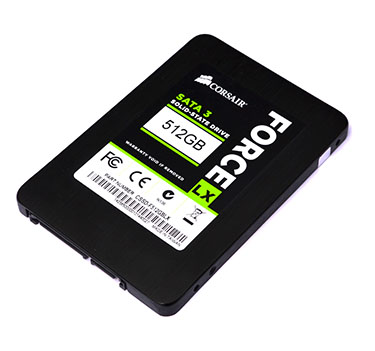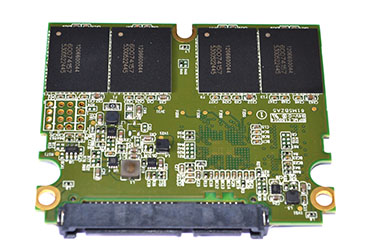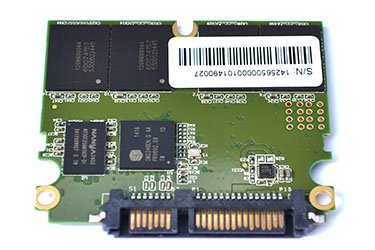Larger-capacity LX
Newer solid-state drives (SSD) are coming to the market thick and fast right now. The price of NAND is falling, driven by moves to smaller manufacturing processes at the factories owned by the biggest players in the industry.
It makes sense for any SSD manufacturer to have compelling mainstream drives in the market. They all offer headline-grabbing sequential read and write speeds, which is probably the most important metric for the average consumer, and they only tend to vary in terms of performance when in a degraded/used state.
Corsair retails seven brands of SSDs. Coming in at the entry level is the Force Series, sub-divided into four categories - GS, GT, LS, and LX. These four use a different combination of controllers and NAND to hit a particular price-to-performance ratio.
Focussing on value, the Force LX is the one to go for. Available in 128GB and 256GB sizes a couple of months ago, Corsair has now added a 512GB drive, priced at £200 or so. Here is how the range stacks up.
Corsair Force LX SSDs |
||||
|---|---|---|---|---|
| Model | 128GB |
256GB |
512GB |
|
| Controller | Silicon Motion SM2246EN |
|||
| NAND | 20nm Micron MLC |
|||
| Total Drive Capacity | 128GB |
256GB |
512GB |
|
| Onboard DDR3 Cache | 256MB |
256MB |
512MB |
|
| Interface | SATA 6Gb/s, compatible with SATA 3Gb/s and 1.5Gb/s |
|||
| Sequential Read Speed | up to 560MB/s |
up to 560MB/s |
up to 560MB/s |
|
| Sequential Write Speed | up to 150MB/s |
up to 300MB/s |
up to 450MB/s |
|
| Random IOPs (4KB Reads) | up to 68,000 IOPs |
up to 76,000 IOPs |
up to 76,000 IOPs |
|
| Random IOPs (4KB Writes) | up to 36,000 IOPs |
up to 70,000 IOPs |
up to 70,000 IOPs |
|
| Available Form Factors | 2.5in |
2.5in |
2.5in |
|
| Active Power Consumption | 4.4W Typical |
|||
| Idle Power Consumption | 0.6W Typical |
|||
| Life Expectancy | 1 million hours Mean Time Between Failures (MTBF) |
|||
| Endurance | TBC |
|||
| Warranty | 3 Years |
|||
| Current Retail Price | £55 |
£93 |
£200 |
|
Entry-level specs
Corsair uses a Silicon Motion SM2246EN controller for the first time on the Force series. A four-channel chip with baked-in support for AES256 encryption and TCG OPAL compatibility, the LX's security credentials are good. Corsair says it will roll out new firmware later on this year for OPAL 2 compatibility, providing support for hardware-accelerated encryption from Microsoft's BitLocker eDrive functionality.
Other specifications meet the expected standard; 76K IOPs random 4K read and 70K IOPs random 4K write is about average for an entry-level SSD in 2014. There's no mention of sustained performance in a used state, which is often the differentiating factor between drives, so we'll have to evaluate that ourselves when running the benchmarks. Sequential write performance is better on this 512GB model than on smaller-capacity Force LXs.
Corsair doesn't provide information on the endurance of the Force LX 512GB, usually quoted in total bytes written over the three-year warranty period. This number is likely to be low because there's no overprovisioning set aside as a NAND buffer for writes; on the flipside, you get access to all the NAND chips can hold.
The drive
In keeping with other SSDs, the Force LX is 7mm tall and presented in the usual 2.5in SATA form factor. The metal casing feels durable and the brushed finish doesn't pick up fingerprints. We like the new livery on the FX range, as the capacity and other information is clearly displayed on the large label.
Drive management is taken care of by Corsair's SSD Toolbox utility. Providing a means by which to secure-erase the drive, clone another drive, update the firmware and optimise the TRIM function, it is one of the easier tools to use.
This is what you're really paying for. A half-height PCB contains eight 20nm IMFT (Intel/Micron) NAND chips. Each carries 64GB in capacity, based on four 128Gbit dies. Writing speed is heavily linked to the number of dies present on the flash, so having 32 enables the controller to take advantage of inherent parallelism. Note that the 256GB model is nowhere near as rapid in this metric. Rounding it off, a 512MB Nanya DDR3 IC provides the necessary space for the controller to buffer normal operations.
Summary
Now available in a 512GB capacity and costing £200, Corsair is bolstering its mainstream SSD line-up with the new Force LX.













